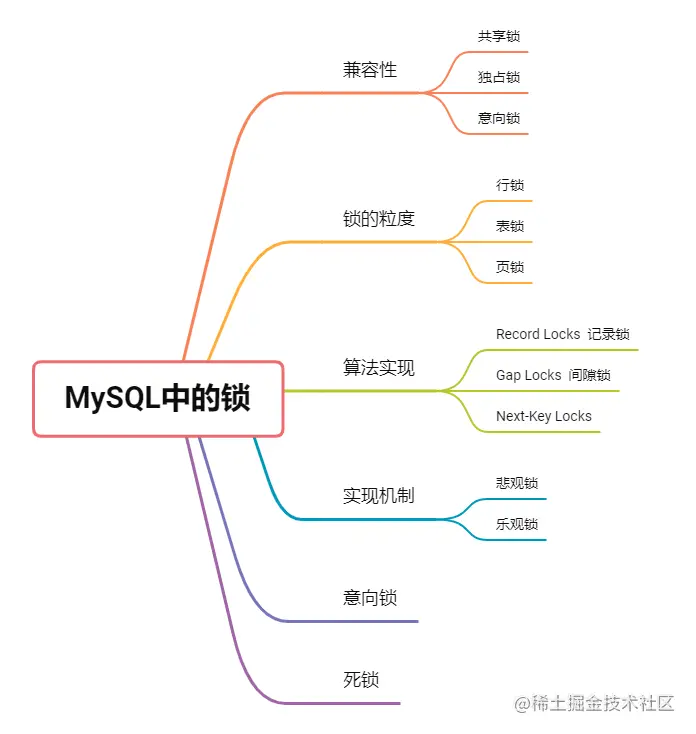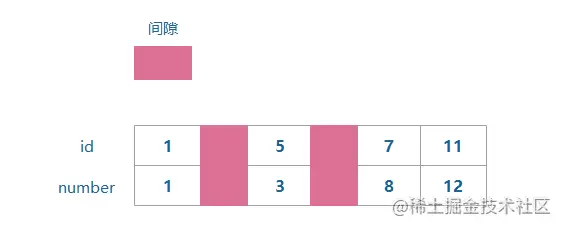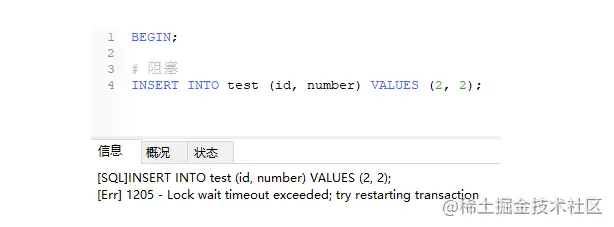MySQL learning to talk about locks and classification
This article will help you understand the locks in MySQL and introduce the granularity classification of locks and the compatibility classification of locks. I hope it will be helpful to you.

1. Database concurrency scenario
In high concurrency scenarios, without considering other middleware, the following scenarios will exist in the database:
- Read: There is no problem and no concurrency control is required.
- Read and write: There are thread safety issues, which may cause transaction isolation issues, and dirty reads, phantom reads, and non-repeatable reads may be encountered.
- Write: There are thread safety issues, and there may be update loss issues, such as the first type of update being lost and the second type of update being lost.
In response to the above problems, the SQL standard stipulates that different problems may occur under different isolation levels:
MySQL four major isolation levels:
| Isolation level | Dirty read | Non-repeatable read | Phantom read | ||||||||||||||||||||||||||||||||||||||||||||||||||||||||||||||||||||||||
|---|---|---|---|---|---|---|---|---|---|---|---|---|---|---|---|---|---|---|---|---|---|---|---|---|---|---|---|---|---|---|---|---|---|---|---|---|---|---|---|---|---|---|---|---|---|---|---|---|---|---|---|---|---|---|---|---|---|---|---|---|---|---|---|---|---|---|---|---|---|---|---|---|---|---|---|
| may occur | may occur | may occur | |||||||||||||||||||||||||||||||||||||||||||||||||||||||||||||||||||||||||
| Solution | May happen | May happen | |||||||||||||||||||||||||||||||||||||||||||||||||||||||||||||||||||||||||
| Solution | Solution | Possible occurrence | |||||||||||||||||||||||||||||||||||||||||||||||||||||||||||||||||||||||||
| Solution | Solution | Solution |
| Row lock | Table lock | Page lock | |||||||||||||||||||||||||||||||||||||||||||||||||||||||||||||||||||||||||
|---|---|---|---|---|---|---|---|---|---|---|---|---|---|---|---|---|---|---|---|---|---|---|---|---|---|---|---|---|---|---|---|---|---|---|---|---|---|---|---|---|---|---|---|---|---|---|---|---|---|---|---|---|---|---|---|---|---|---|---|---|---|---|---|---|---|---|---|---|---|---|---|---|---|---|---|
| Lock granularity | small | 大 | between the two | ||||||||||||||||||||||||||||||||||||||||||||||||||||||||||||||||||||||||
| add Lock efficiency | Slow | Fast | Between the two | ||||||||||||||||||||||||||||||||||||||||||||||||||||||||||||||||||||||||
| Conflict probability | Low | High | - | ||||||||||||||||||||||||||||||||||||||||||||||||||||||||||||||||||||||||
| High | Low | General | |||||||||||||||||||||||||||||||||||||||||||||||||||||||||||||||||||||||||
| Big | Small | Between the two | |||||||||||||||||||||||||||||||||||||||||||||||||||||||||||||||||||||||||
| whether or not |
| IS | X | IX | |||||||||||||||||||||
|---|---|---|---|---|---|---|---|---|---|---|---|---|---|---|---|---|---|---|---|---|---|---|---|
| Compatible | Compatible | Incompatible | Incompatible | ||||||||||||||||||||
| Compatible | Compatible | Incompatible | Incompatible | ||||||||||||||||||||
| Not compatible | Not compatible | Not compatible | Not compatible | ||||||||||||||||||||
| Compatible | Compatible | Incompatible | Incompatible |
| Row lock | Table lock | Page lock | |||||||||||||||||||||
|---|---|---|---|---|---|---|---|---|---|---|---|---|---|---|---|---|---|---|---|---|---|---|---|
| Lock granularity | small | 大 | between the two | ||||||||||||||||||||
| add Lock efficiency | Slow | Fast | Between the two | ||||||||||||||||||||
| Conflict probability | Low | High | - | ||||||||||||||||||||
| High | Low | General | |||||||||||||||||||||
| Big | Small | Between the two | |||||||||||||||||||||
| whether or not |
| A | B | |
|---|---|---|
| ① | BEGIN | |
| ② | BEGIN | |
| ③ | SELECT * FROM user WHERE name='a' FOR UPDATE |
|
| ④ | SELECT * FROM user WHERE name='b' FOR UPDATE |
|
| ⑤ | SELECT * FROM user WHERE name='b' FOR UPDATE |
|
| ⑥ | SELECT * FROM user WHERE name='a' FOR UPDATE |
1、开启 A、B 两个事务;
2、首先 A 先查询name='a'的数据,然后 B 也查询name='b'的数据;
3、在 B 没释放锁的情况下,A 尝试对 name='b'的数据加锁,此时会阻塞;
4、若此时,事务 B 在没释放锁的情况下尝试对 name='a'的数据加锁,则产生死锁。

此时,MySQL 检测到了死锁,并结束了 B 中事务的执行,此时,切回事务 A,发现原本阻塞的 SQL 语句执行完成了。可通过show engine innodb status \G查看死锁。
如何避免
从上面的案例可以看出,死锁的关键在于:两个(或以上)的 Session 加锁的顺序不一致,所以我们在执行 SQL 操作的时候要让加锁顺序一致,尽可能一次性锁定所需的数据行。
【相关推荐:mysql视频教程】
The above is the detailed content of MySQL learning to talk about locks and classification. For more information, please follow other related articles on the PHP Chinese website!

Hot AI Tools

Undresser.AI Undress
AI-powered app for creating realistic nude photos

AI Clothes Remover
Online AI tool for removing clothes from photos.

Undress AI Tool
Undress images for free

Clothoff.io
AI clothes remover

Video Face Swap
Swap faces in any video effortlessly with our completely free AI face swap tool!

Hot Article

Hot Tools

Notepad++7.3.1
Easy-to-use and free code editor

SublimeText3 Chinese version
Chinese version, very easy to use

Zend Studio 13.0.1
Powerful PHP integrated development environment

Dreamweaver CS6
Visual web development tools

SublimeText3 Mac version
God-level code editing software (SublimeText3)

Hot Topics
 1667
1667
 14
14
 1426
1426
 52
52
 1328
1328
 25
25
 1273
1273
 29
29
 1255
1255
 24
24
 Laravel Introduction Example
Apr 18, 2025 pm 12:45 PM
Laravel Introduction Example
Apr 18, 2025 pm 12:45 PM
Laravel is a PHP framework for easy building of web applications. It provides a range of powerful features including: Installation: Install the Laravel CLI globally with Composer and create applications in the project directory. Routing: Define the relationship between the URL and the handler in routes/web.php. View: Create a view in resources/views to render the application's interface. Database Integration: Provides out-of-the-box integration with databases such as MySQL and uses migration to create and modify tables. Model and Controller: The model represents the database entity and the controller processes HTTP requests.
 MySQL and phpMyAdmin: Core Features and Functions
Apr 22, 2025 am 12:12 AM
MySQL and phpMyAdmin: Core Features and Functions
Apr 22, 2025 am 12:12 AM
MySQL and phpMyAdmin are powerful database management tools. 1) MySQL is used to create databases and tables, and to execute DML and SQL queries. 2) phpMyAdmin provides an intuitive interface for database management, table structure management, data operations and user permission management.
 MySQL vs. Other Programming Languages: A Comparison
Apr 19, 2025 am 12:22 AM
MySQL vs. Other Programming Languages: A Comparison
Apr 19, 2025 am 12:22 AM
Compared with other programming languages, MySQL is mainly used to store and manage data, while other languages such as Python, Java, and C are used for logical processing and application development. MySQL is known for its high performance, scalability and cross-platform support, suitable for data management needs, while other languages have advantages in their respective fields such as data analytics, enterprise applications, and system programming.
 Solve database connection problem: a practical case of using minii/db library
Apr 18, 2025 am 07:09 AM
Solve database connection problem: a practical case of using minii/db library
Apr 18, 2025 am 07:09 AM
I encountered a tricky problem when developing a small application: the need to quickly integrate a lightweight database operation library. After trying multiple libraries, I found that they either have too much functionality or are not very compatible. Eventually, I found minii/db, a simplified version based on Yii2 that solved my problem perfectly.
 Laravel framework installation method
Apr 18, 2025 pm 12:54 PM
Laravel framework installation method
Apr 18, 2025 pm 12:54 PM
Article summary: This article provides detailed step-by-step instructions to guide readers on how to easily install the Laravel framework. Laravel is a powerful PHP framework that speeds up the development process of web applications. This tutorial covers the installation process from system requirements to configuring databases and setting up routing. By following these steps, readers can quickly and efficiently lay a solid foundation for their Laravel project.
 Solve MySQL mode problem: The experience of using the TheliaMySQLModesChecker module
Apr 18, 2025 am 08:42 AM
Solve MySQL mode problem: The experience of using the TheliaMySQLModesChecker module
Apr 18, 2025 am 08:42 AM
When developing an e-commerce website using Thelia, I encountered a tricky problem: MySQL mode is not set properly, causing some features to not function properly. After some exploration, I found a module called TheliaMySQLModesChecker, which is able to automatically fix the MySQL pattern required by Thelia, completely solving my troubles.
 Explain the purpose of foreign keys in MySQL.
Apr 25, 2025 am 12:17 AM
Explain the purpose of foreign keys in MySQL.
Apr 25, 2025 am 12:17 AM
In MySQL, the function of foreign keys is to establish the relationship between tables and ensure the consistency and integrity of the data. Foreign keys maintain the effectiveness of data through reference integrity checks and cascading operations. Pay attention to performance optimization and avoid common errors when using them.
 Compare and contrast MySQL and MariaDB.
Apr 26, 2025 am 12:08 AM
Compare and contrast MySQL and MariaDB.
Apr 26, 2025 am 12:08 AM
The main difference between MySQL and MariaDB is performance, functionality and license: 1. MySQL is developed by Oracle, and MariaDB is its fork. 2. MariaDB may perform better in high load environments. 3.MariaDB provides more storage engines and functions. 4.MySQL adopts a dual license, and MariaDB is completely open source. The existing infrastructure, performance requirements, functional requirements and license costs should be taken into account when choosing.







